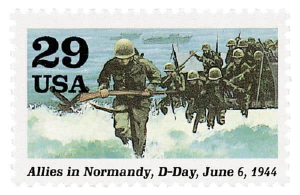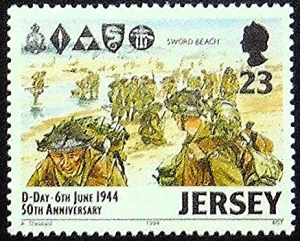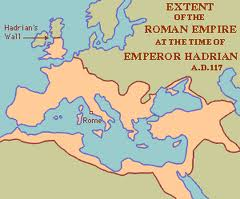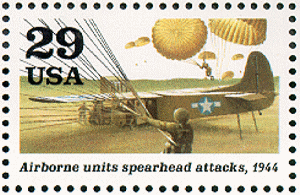June 6th – D-Day, Longest Day – Scots book of days
 June 6 1944 The Longest Day D-Day Autumn leaves are falling. Liberation of Europe, France, and Paris. In Stephen Ambrose’s D-Day, June 6, 1944: The Climactic Battle of World War II, he writes,
June 6 1944 The Longest Day D-Day Autumn leaves are falling. Liberation of Europe, France, and Paris. In Stephen Ambrose’s D-Day, June 6, 1944: The Climactic Battle of World War II, he writes,
Time magazine reported on June 12 [1944] that “as far as the U.S. Army can determine, the first use of D for Day, H for Hour was in Field Order No. 8, of the First Army, A.E.F., issued on Sept. 20, 1918, which read, ‘The First Army will attack at H-Hour on D-Day with the object of forcing the evacuation of the St. Mihiel salient.’” (p. 491)
 For military planners (and later historians), the days before and after a D-Day were indicated using plus and minus signs: D-4 meant four days before a D-Day, while D+7 meant seven days after a D-Day. Many explanations have been given for the meaning of D-Day, June 6, 1944, the day the Allies invaded Normandy from England during World War II. In 1964, General Eisenhower when asked for an explanation, his executive assistant Brigadier General Robert Schultz answered:
For military planners (and later historians), the days before and after a D-Day were indicated using plus and minus signs: D-4 meant four days before a D-Day, while D+7 meant seven days after a D-Day. Many explanations have been given for the meaning of D-Day, June 6, 1944, the day the Allies invaded Normandy from England during World War II. In 1964, General Eisenhower when asked for an explanation, his executive assistant Brigadier General Robert Schultz answered:
- “General Eisenhower asked me to respond to your letter. Be advised that any amphibious operation has a ‘departed date’; therefore the shortened term ‘D-Day’ is used.” (p.146)
http://usarmy.vo.llnwd.net/e2/rv5_downloads/d-day/the-meaning-of-dday-fact.pdf
 Scots Commanders included Bernard Montgomery, and Bertram Ramsay.
Scots Commanders included Bernard Montgomery, and Bertram Ramsay.
Brigadier Simon Fraser, 15th Lord Lovat, landed at Sword Beach
422 Hadrian’s wall. Sometime this year. Emperor Honorius sent a legion to repair the wall. Caledonians driven back to north. Tytler’s History of Scotland from Britannica 4.
driven back to north. Tytler’s History of Scotland from Britannica 4.
Map of Hadrian’s wall.
 1237 John of Scotland, Earl of Huntingdon (1207 – 6 June 1237), 7th Earl of Chester, married Elen ferch Llywelyn. John succeeded his uncle Ranulf as Earl of Chester in 1232, As cousin of Alexander II, he was in line of succession for the throne, but died childless. Huntington is now a station on the Yellow line for the Washington Metro rail, named for the Virginia village, founded by Collis Potter Huntington (October 22, 1821 – August 13, 1900) 4th great grand son of Puritans arriving in New England in 1638. The Presbyterians were Puritans. John’s sister Isobel of Huntingdon was ancestress of Robert the Bruce.
1237 John of Scotland, Earl of Huntingdon (1207 – 6 June 1237), 7th Earl of Chester, married Elen ferch Llywelyn. John succeeded his uncle Ranulf as Earl of Chester in 1232, As cousin of Alexander II, he was in line of succession for the throne, but died childless. Huntington is now a station on the Yellow line for the Washington Metro rail, named for the Virginia village, founded by Collis Potter Huntington (October 22, 1821 – August 13, 1900) 4th great grand son of Puritans arriving in New England in 1638. The Presbyterians were Puritans. John’s sister Isobel of Huntingdon was ancestress of Robert the Bruce.
 1513 The Battle of Novara, Northern Italy, French were attacked by a Swiss relief army and were routed despite having superior numbers. The French battles this year versus English, Spanish and Swiss, will prompt the French Queen to plead for aid of King James 4th of Scots, leading to the disaster at Flodden. The Auld Alliance in the War of the League of Cambrai. Illustration of the battle of Novara in the chronicle of Johannes Stumpf, 1548. Wikipedia.
1513 The Battle of Novara, Northern Italy, French were attacked by a Swiss relief army and were routed despite having superior numbers. The French battles this year versus English, Spanish and Swiss, will prompt the French Queen to plead for aid of King James 4th of Scots, leading to the disaster at Flodden. The Auld Alliance in the War of the League of Cambrai. Illustration of the battle of Novara in the chronicle of Johannes Stumpf, 1548. Wikipedia.
 1673 Colonel James Hamilton had one of his legs blown off by a cannonball in a sea-fight with the Dutch (presumably the Battle of Schooneveld), and died as a result thereof on 6 June 1673. [Hamilton 2Stewart 2Millar 2simmons 2Choate 2Sorensen] The First Battle of Schooneveld, 28 May 1673 or The First Battle of Schooneveld, 28 May 1673. W V Velde f. 1684 / oudt. 73 Jaren commons.wikimedia.org /wiki/File: Van_de_Velde,_Battle_of_Schooneveld.jpg
1673 Colonel James Hamilton had one of his legs blown off by a cannonball in a sea-fight with the Dutch (presumably the Battle of Schooneveld), and died as a result thereof on 6 June 1673. [Hamilton 2Stewart 2Millar 2simmons 2Choate 2Sorensen] The First Battle of Schooneveld, 28 May 1673 or The First Battle of Schooneveld, 28 May 1673. W V Velde f. 1684 / oudt. 73 Jaren commons.wikimedia.org /wiki/File: Van_de_Velde,_Battle_of_Schooneveld.jpg
1790 sometime in June. Burns wrote to Grose in June 1790, giving him three witch stories associated with Alloway Kirk, two of which he said were “authentic”, the third, “though equally true, being not so well identified as the two former with regard to the scene”. The second of the stories was, in fact, Tam o’ Shanter. This is Burns’ prose sketch of it to Grose:
On a market-day, in the town of Ayr, a farmer from Carrick, and consequently whose way lay by the very gate of Alloway kirk-yard, in order to cross the River Doon, at the old bridge, which is almost two or three hundred yards farther on than the said old gate, had been detained by his business till by the time he reached Alloway it was the wizard hour, between night and morning.
Though he was terrified with a kirk blaze, yet as is known fact, to turn bac k is by far the greatest mischief, he prudently advanced on his road. When he had reached the gate of the kirk-yard, he was surprised and entertained, through the ribs and arches of an old gothic window which still faces the highway, to see a dance of witches merrily footing it round their old sooty black-guard master, who was keeping them all alive with the power of his bagpipe. Tam O’Shanter and the Witches By John Faed English artist born 1820 – died 1902. www.1st-art-gallery.com/John-Faed/Tam-O’shanter-And-The-Witches.html
k is by far the greatest mischief, he prudently advanced on his road. When he had reached the gate of the kirk-yard, he was surprised and entertained, through the ribs and arches of an old gothic window which still faces the highway, to see a dance of witches merrily footing it round their old sooty black-guard master, who was keeping them all alive with the power of his bagpipe. Tam O’Shanter and the Witches By John Faed English artist born 1820 – died 1902. www.1st-art-gallery.com/John-Faed/Tam-O’shanter-And-The-Witches.html
The farmer stopping his horse to observe them a little, could plainly discern the faces of many old women of his acquaintance and neighbourhood. How the gentleman was dressed, tradition does not say; but the ladies were all in their smocks; and one of them happening unluckily to have a smock which was considerably too short to answer all the purpose of that piece of dress, our farmer was so tickled that he involuntarily burst out, with a loud laugh, ‘Weel luppen, Maggy wi’ the short sark!’ and recollecting himself, instantly spurred his horse to the top of his speed. I need not mention the universally known fact, that no diabolical power can pursue ye beyond the middle of a running stream.  Lucky it was for the poor farmer that the river Doon was so near, for notwithstanding the speed of his horse, which was a good one, against he reached the middle of the arch of the bridge and consequently the middle of the stream, the pursuing, vengeful hags were so close at his heels, that one of them actually sprung to seize him: but it was too late; nothing was on her side of the stream but the horse’s tail, which immediately gave way to her infernal grip, as if blasted by a stroke of lightning; but the farmer was beyond her reach. However, the unsightly, tailless condition of the vigorous steed was to the last hours of the noble creature’s life, an awful warning to the Carrick farmers, not to stay too late in Ayr markets. Tam O’SHanter. 1866 Victorian. John Joseph Barker (1824-1904).
Lucky it was for the poor farmer that the river Doon was so near, for notwithstanding the speed of his horse, which was a good one, against he reached the middle of the arch of the bridge and consequently the middle of the stream, the pursuing, vengeful hags were so close at his heels, that one of them actually sprung to seize him: but it was too late; nothing was on her side of the stream but the horse’s tail, which immediately gave way to her infernal grip, as if blasted by a stroke of lightning; but the farmer was beyond her reach. However, the unsightly, tailless condition of the vigorous steed was to the last hours of the noble creature’s life, an awful warning to the Carrick farmers, not to stay too late in Ayr markets. Tam O’SHanter. 1866 Victorian. John Joseph Barker (1824-1904).  The tam o’shanter is a bonnet worn by Scots and named for the character Tam o’ Shanter in the poem by Robert Burns. The bonnet is made of wool with a toorie (pompon) in the centre, and the crown is about twice the diameter of the head. Originally they were only made in blue because of the lack of chemical dyes, and were called Bluebonnets. They are now available in plain colors or in different tartans. beretandboina.blogspot.com
The tam o’shanter is a bonnet worn by Scots and named for the character Tam o’ Shanter in the poem by Robert Burns. The bonnet is made of wool with a toorie (pompon) in the centre, and the crown is about twice the diameter of the head. Originally they were only made in blue because of the lack of chemical dyes, and were called Bluebonnets. They are now available in plain colors or in different tartans. beretandboina.blogspot.com
1840 Reuben Hedlock joined Elder Wright in Paisley and on June 6th they raised up a branch of the Church of Jesus Christ at Bridge-of-Weir.
Weir Crest: Upon a chapeau Gules furred Ermine a boar statant Azure armed Or. Motto: VERO NIHIL VERIUS. [from Latin: “Nothing truer than truth”]. Crest badge derived from the arms of Weir of Blackwood.
 1944 Road to Victory. Invasion of Normandy. D-Day.
1944 Road to Victory. Invasion of Normandy. D-Day.
1962 The Longest Day is a 1962 war film based on the 1959 history book The Longest Day by Cornelius Ryan, about D-Day, the Normandy landings on 6 June 1944, during World War 2. Brigadier Lord Lovat (Commander 1st Special Service Brigade) portrayed by Peter Lawford, Simon Fraser (clan Fraser) 15th Lord Lovat, and 25th chief of the Clan Fraser. Private Bill Millin, No.4 Commando, Piper on Beach portrayed by Leslie de Laspee, Field Marshal Bernard Law Montgomery, 1st Viscount Montgomery of Alamein, KG, GCB, DSO, PC17 November 1887 – 24 March 1976), nicknamed “Monty” and the “Spartan General” (clan Montgomery), Commander Allied Ground Forces, portrayed by Trevor Reid. Admiral Bertram Ramsay (clan Ramsay) commander Allied Naval Forces, portrayed by John Robinson.
 1994 World War II Commemorative 50th anniversary D-Day landings. 1994-06-06. Ships loaded with a million troops fueled in English and Scots ports. Planes loaded. Airborne troops are trained and equipped to go into battle from the air, particularly by parachute. Units in which all members must be parachutists are generally considered airborne regardless of how they are deployed. Principal advantages of airborne operations are surprise, the ability to bypass ground defenses, and speed of movement from assembly areas to distant targets. British and American airborne forces were successfully used in the later stages of World War II, particularly in the Normandy invasion.
1994 World War II Commemorative 50th anniversary D-Day landings. 1994-06-06. Ships loaded with a million troops fueled in English and Scots ports. Planes loaded. Airborne troops are trained and equipped to go into battle from the air, particularly by parachute. Units in which all members must be parachutists are generally considered airborne regardless of how they are deployed. Principal advantages of airborne operations are surprise, the ability to bypass ground defenses, and speed of movement from assembly areas to distant targets. British and American airborne forces were successfully used in the later stages of World War II, particularly in the Normandy invasion.
 2004 D-Day Landings 60th Anniversary 60th anniversary. Winston Churchill (clan Montgomery). http://www.bfdc.co.uk/2004/ souvenir_covers/operation_overlord1.html
2004 D-Day Landings 60th Anniversary 60th anniversary. Winston Churchill (clan Montgomery). http://www.bfdc.co.uk/2004/ souvenir_covers/operation_overlord1.html
 2006 60th anniversary. (clan McMILLIN) Scotland’s Bill Millin, 81, Honored in Normandy and on Stamp. Scotland’s “Mad Piper” Bill Millin, who played on the beaches for his regiment on June 6, 1944. Millin’s brigadier that day, Lord Lovat, (clan Fraser) had specifically ignored the general order against bagpipers issued for 9,000 Scottish troops participating in the attack. Millin held the bagpipes above his head in the waves, making it to the beach amid the chaos and mayhem. He managed to avoid mortars and machine gun fire to play “The Road to the Isles” and march at Lovat’s request. When two captured German snipers were later asked why they didn’t shoot the piper, they replied that they thought he was crazy — hence Millin’s nickname of “The Mad Piper.” Millin, now 81 [in 2006], will be honored in Normandy at 60th anniversary ceremonies and his pipes and uniform from D-Day are on permanent display in Edinburgh Castle. www.wbur.org/npr/1923053/the-mad-piper-of-d-day
2006 60th anniversary. (clan McMILLIN) Scotland’s Bill Millin, 81, Honored in Normandy and on Stamp. Scotland’s “Mad Piper” Bill Millin, who played on the beaches for his regiment on June 6, 1944. Millin’s brigadier that day, Lord Lovat, (clan Fraser) had specifically ignored the general order against bagpipers issued for 9,000 Scottish troops participating in the attack. Millin held the bagpipes above his head in the waves, making it to the beach amid the chaos and mayhem. He managed to avoid mortars and machine gun fire to play “The Road to the Isles” and march at Lovat’s request. When two captured German snipers were later asked why they didn’t shoot the piper, they replied that they thought he was crazy — hence Millin’s nickname of “The Mad Piper.” Millin, now 81 [in 2006], will be honored in Normandy at 60th anniversary ceremonies and his pipes and uniform from D-Day are on permanent display in Edinburgh Castle. www.wbur.org/npr/1923053/the-mad-piper-of-d-day
 Awesome courage of the D-Day piper who the Nazis thought was mad. By SUE REID
04:55 EST, 20 August 2010
Awesome courage of the D-Day piper who the Nazis thought was mad. By SUE REID
04:55 EST, 20 August 2010
 1979 Bicentenary of the Derby , 1779-1979. The Scottish Derby began in 1979, and run at Ayr over a mile and 2 furlongs. Apparently it took its name to the races run at Derby since 1779. The Scottish Derby was last run in 2005. Wikipedia.
1979 Bicentenary of the Derby , 1779-1979. The Scottish Derby began in 1979, and run at Ayr over a mile and 2 furlongs. Apparently it took its name to the races run at Derby since 1779. The Scottish Derby was last run in 2005. Wikipedia.

 Horseracing paintings and Bicentenary of The Derby, 6 June 1979
Horseracing paintings and Bicentenary of The Derby, 6 June 1979 
1979 13 P Racing at Dorsett Ferry, Windsor 1684.
1979 10 ½ P The Liverpool Great National Steeple Chase 1839
1979 9P Saddling Mahmoud for The Derby 1936
 1979 11P The First Spring Meeting, Newmarket 1793
1979 11P The First Spring Meeting, Newmarket 1793
Disclaimer: The author of each article published on this web site owns his or her own words. The opinions, beliefs and viewpoints expressed by the various authors and forum participants on this site do not necessarily reflect the opinions, beliefs and viewpoints of Utah Standard News or official policies of the USN and may actually reflect positions that USN actively opposes. No claim in public domain or fair use. © John Choate
Utah Standard News depends on the support of readers like you.
Good Journalism requires time, expertise, passion and money. We know you appreciate the coverage here. Please help us to continue as an alternative news website by becoming a subscriber or making a donation. To learn more about our subscription options or make a donation, click here.
To Advertise on UtahStandardNews.com, please contact us at: ed@utahstandardnews.com.


Comments - No Responses to “June 6th – D-Day, Longest Day – Scots book of days”
Sure is empty down here...